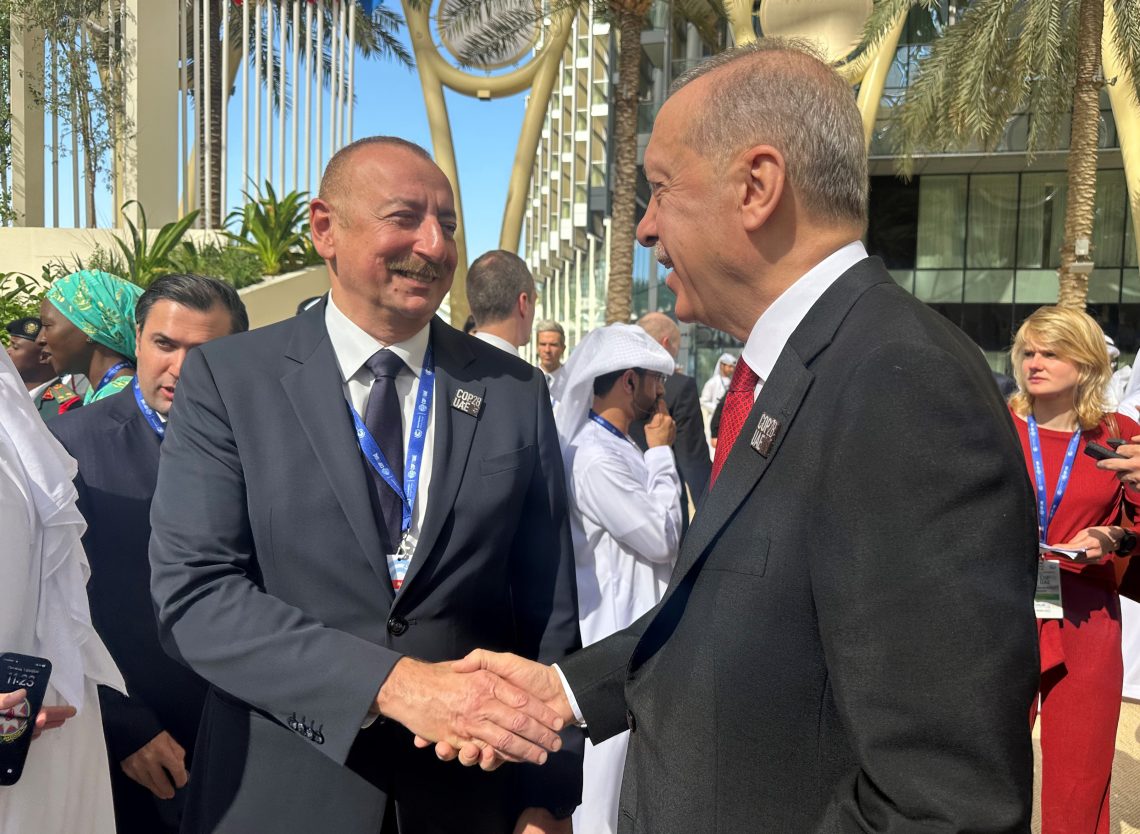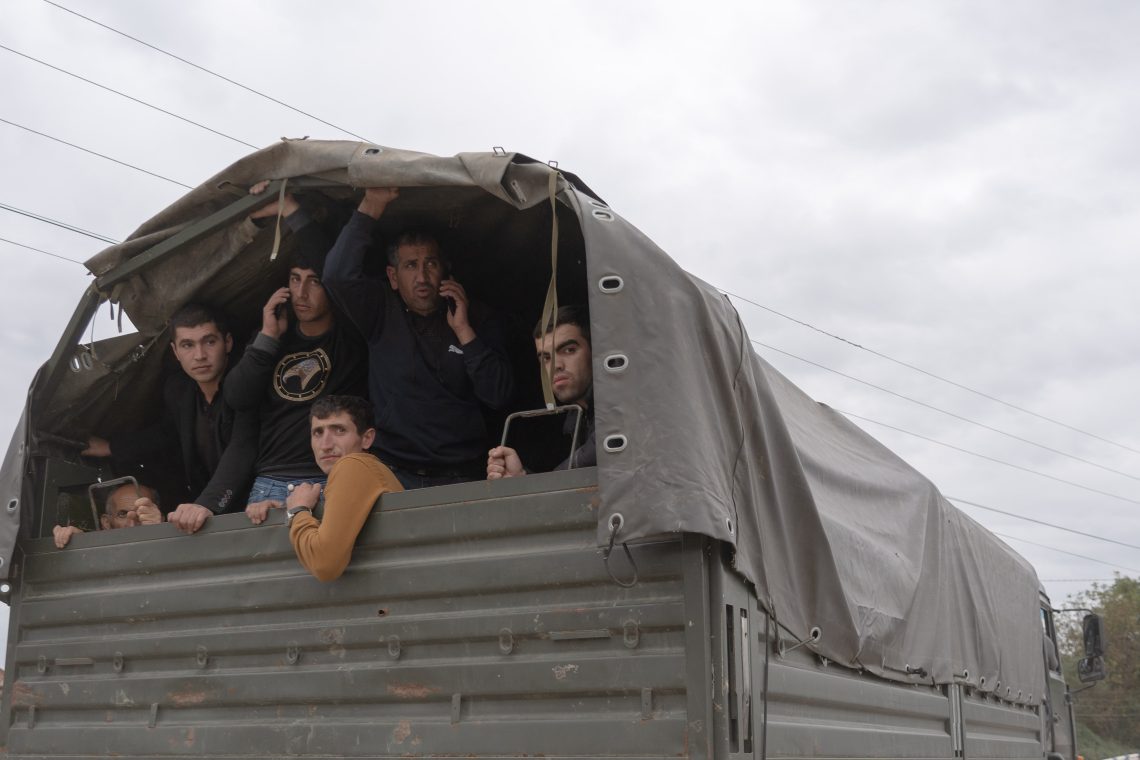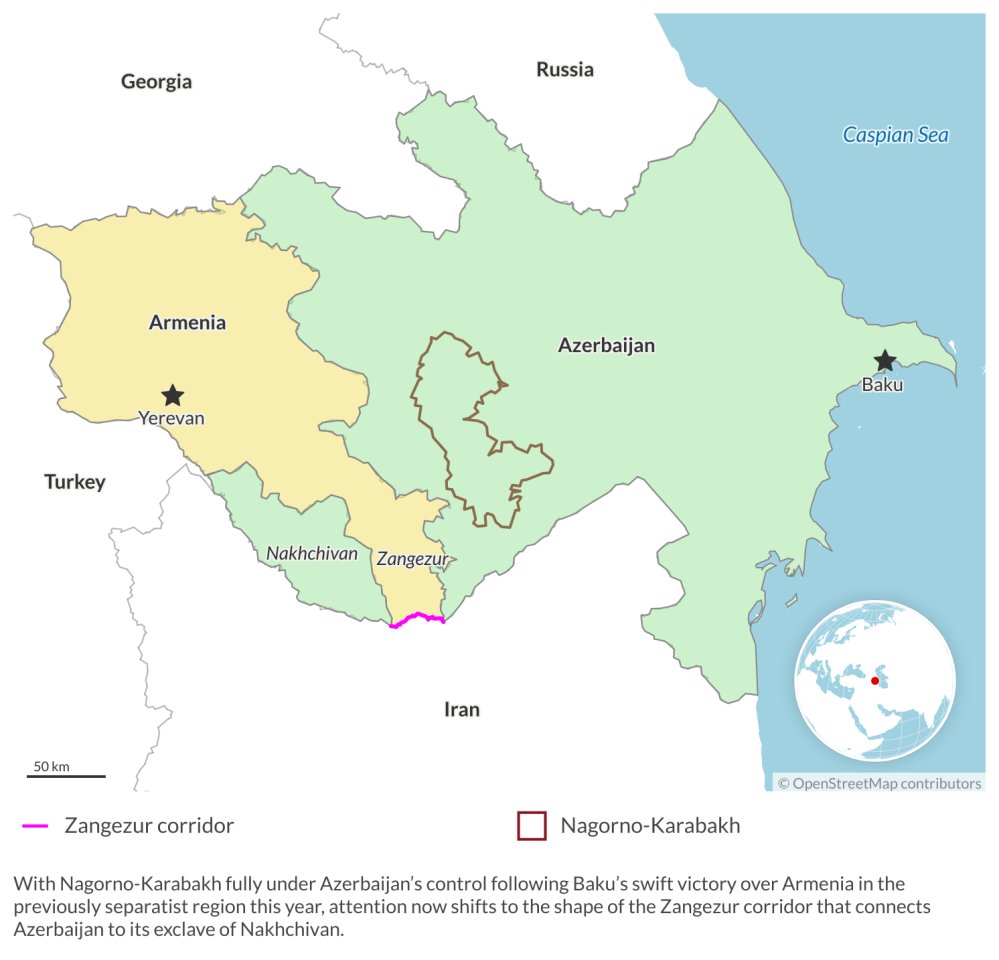New masters in the South Caucasus
Armenia lost Nagorno-Karabakh, but the regional ambitions of Azerbaijan supported by Turkey may mean that the worst is not over for Yerevan.

In a nutshell
- Turkey and Azerbaijan are the undisputed leaders in the South Caucasus
- Armenia is vulnerable after losing the 35-year conflict over Nagorno-Karabakh
- The Kremlin’s regional influence also took a hit over Yerevan’s swift defeat
Following the one-day war fought between Armenia and Azerbaijan on September 19, Turkey and Azerbaijan are now in full control of geopolitics in the South Caucasus. The focus of the emerging axis between Ankara and Baku had been to once and for all resolve the conflict over Nagorno-Karabakh. Following 35 years of intermittent warfare, that objective has now been achieved, at the great expense of Armenia – and of Russia.
The self-styled Republic of Artsakh will soon cease to exist. Unilaterally established by ethnic Armenians in the autonomous Azeri province of Nagorno-Karabakh, it was the linchpin of Russian hegemony in the region. Playing both sides, the Kremlin ensured that it had the final say in regional developments. The one-day war produced two important results: all ethnic Armenians residing in Artsakh were forced to flee, and Azerbaijan is now in full control of its own, internationally recognized territory.
This fundamentally alters the security architecture in the geopolitically important South Caucasus region. As the scope for outside mediation will now be defined by Ankara and Baku, there will be no more outside “peace plans.”
Following the cease-fire agreement in 1994, Armenia assumed the role of protector for the Republic of Artsakh, and it retained control of those Azeri territories between Nagorno-Karabakh and Armenia proper that it had seized by military force. Although Artsakh was not formally recognized even by Yerevan, it represented a substantial de facto enlargement of the territory of Armenia.
Azerbaijan’s long push to retake Nagorno-Karabakh
Backed by Turkey, Azerbaijan executed its counteroffensive in three stages. The 44-day war in the fall of 2020 resulted in Baku regaining control over a large part of Nagorno-Karabakh and in a rout of the bulk of the Armenian forces from the surrounding areas. Russian intervention prevented a total collapse of the Armenian side, and 2,000 Russian peacekeepers were deployed to ensure continued free passage between Artsakh and Armenia. The second stage was a blockade that made life for the remaining Armenians inside Artsakh very difficult. The third and final stage was the assault on September 19, which ended in swift capitulation by the Armenian forces.
Turkey and Azerbaijan are the unequivocal winners. They will now be able to dictate the conditions for what will follow. The biggest loser in the short term is Armenia. With a population of 2.8 million, it has been forced to accept 100,000 refugees and it lives under the threat of an Azeri invasion. Although both sides have offered to recognize the territorial integrity of the other side, Baku maintains strategic ambiguity by referring to remaining Azeri exclaves inside Armenia as “Western Azerbaijan.”
More by Stefan Hedlund
The fallout of Azerbaijan’s victory over Armenia
Uzbekistan may have another president for life
Georgia’s divide between Russia and the West
Armenia seeks closer ties to the West
Having long believed it was protected by Russia, Armenia has started currying favor with the West. It has not only reneged on a pledge to host drills of the Russian-led Common Security Treaty Organization. On October 3, it crossed the Rubicon by opting to ratify the Rome Statute of the International Criminal Court. That means that if President Vladimir Putin were to visit Armenia, he would risk being arrested. Kremlin spokesman Dmitry Peskov branded this move as “extremely hostile” and threatened there would be the “most negative consequences.” But the only consequence to date has been that Russian customs is making trouble for imports of Armenian brandy.
Russian peacekeepers exit the region
These moves indicate how much Russia has lost. Its peacekeepers are getting ready to leave Azerbaijan. They were subjected to intermittent shelling of their bases that destroyed equipment and the killing of several Russian soldiers, including a senior Russian commander. No escalation followed. The Kremlin is so dependent on its transport route to Iran that it was forced to accept this humiliation, or risk antagonizing Azerbaijan.
Russia has been informed that once its peacekeepers have left Azeri territory, they will not be welcome in Armenia, and it is likely that in addition it will be asked to vacate its remaining bases on Armenian territory.
Before the full-scale invasion of Ukraine, Armenia was home to around 10,000 Russian troops. About half were stationed at the 102nd military base at Gyumri, the second-largest city in Armenia. Located near Turkey, it was the largest Russian military base abroad. Additional garrisons have been at Zvartnots airport and at Erebuni military base. Russian border guards have also patrolled the borders with Turkey and Iran. Given that many of these troops have been sent to the “meat grinder” in Ukraine, it is not clear how many are left. Yet, being called on to leave completely would be a major setback.

A formal peace treaty awaits
The immediate future will be marked by efforts to finalize a formal peace treaty. This process has long been pursued along two tracks, one with Russia and the other with the European Union and the United States. Now it is up to Azerbaijan to decide both the terms of a treaty and where it is to be signed. Given that the Armenian population has been displaced from Nagorno-Karabakh, and that both sides have offered to recognize the territorial integrity of the other, there is not much left to talk about. Yet, the outcome is shrouded in uncertainty.
On October 5, the two sides were to meet at Granada, Spain, together with French President Emmanuel Macron, German Chancellor Olaf Scholz and European Council President Charles Michel. Although Armenian Prime Minister Nikol Pashinyan did show up, Azeri President Ilham Aliyev did not. In a clear snub to France, and to aspiring Western mediators, he hinted at dissatisfaction with President Macron’s pro-Armenian statements and talk about French arms sales.
A few days later, the two sides were to meet at a summit meeting of the Russian-led Commonwealth of Independent States (CIS), held in Bishkek in Kyrgyzstan. This time President Aliyev showed up, but in a clear snub to Russia, Prime Minister Pashinyan did not.
The likely venue is Georgia. In late 2021, it refused to take part in a 3+3 format, where the three regional powers Armenia, Azerbaijan and Georgia were to meet with the three outside powers Iran, Russia and Turkey. Tbilisi argued that negotiations should be left to the three regional powers. On October 8, 2023, President Aliyev held a meeting in Tbilisi with Georgian Prime Minister Irakli Garibashvili. On October 26, 2023, at the 4th Tbilisi Silk Road Forum in Tbilisi, prime ministers from regional powers Georgia, Armenia and Azerbaijan, also in Tbilisi, met and Prime Minister Pashinyan proclaimed a peace deal would be signed “in the coming months.”
Facts & figures
Turkey’s role in the dispute
Given that Turkey is now emerging as a regional hegemon, the future will be shaped by President Recep Tayyip Erdogan’s strategic priorities in positioning Turkey as a regional energy hub and in securing its access to markets in Central Asia without passing through Iran. Both highlight relations with Azerbaijan, which in turn means that opening the Zangezur corridor to link Azerbaijan proper with its Nakhichevan exclave, crossing Armenian territory, becomes a Turkish priority.
President Erdogan has played a deliberately opaque game. First, he wanted a seamless corridor that would be beyond Armenian sovereignty. Next, he suggested that Armenian checkpoints would be accepted, and the latest is that a corridor may be drawn to Nakhchivan via Iran (pandering to Tehran’s strong objections to a pan-Turkic corridor). In mid-October, he suggested that “If Armenia honors its commitments, especially the opening of the Zangezur corridor, then Turkey will step-by-step normalize relations.”
What is quite clear is that Russia will have no further role to play. According to the trilateral agreement that was signed in 2020, envisioning an opening of Zangezur, it was stipulated that Russian border guards would be in control. In a recent statement, however, Prime Minister Pashinyan stated that “no third power should have control over any territory of Armenia.”
Georgia in contrast will play a vital role. Apart from being a possible venue for peace talks, it is of great strategic relevance to Russia. As the Ukrainian armed forces are pushing the Russian Black Sea Fleet out of its bases on Crimea, the Kremlin needs to find an alternative. Given that its port at Novorossiysk is too small, it is looking at a port in Abkhazia, which is a de facto Russian vassal state. While Georgia cries foul in public, the current government may play along.
Scenarios
Unlikely: Azerbaijan invades Armenia
Three very different scenarios may play out. One is that Azerbaijan acts on its implied threats and takes further military action against Armenia. It has already launched a series of cross-border attacks that have resulted in the occupation of about 215 square kilometers of Armenian land. The rhetoric on “Western Azerbaijan” is driven by the legacy of eight exclaves inside Armenia that, during Soviet times, were populated by ethnic Azeris. Two of those – Yukhari Askipara and Barkhudari – are located on the Yerevan-Tbilisi highway, which could be cut off.
What makes this scenario unlikely is that it would lead to powerful reactions from the West. The United States has sent strong signals warning against an invasion of Armenia, and Baku must consider the heavy investment it has made in being a reliable supplier of energy to Europe. The purpose in keeping the threat alive is to add pressure on the government in Yerevan.
Possible: Western intervention
A radically different scenario envisions a decisive intervention by the EU and the U.S. to bring the region closer to the West. The track record of such ambitions has not been good. When Brussels launched its European Neighborhood Policy, Georgia was the only country in the South Caucasus to show interest. Azerbaijan preferred to tread its own middle road and Armenia felt safe with Russia. Since then, the increasingly pro-Russian Georgian government has moved away from the EU. When Moldova and Ukraine were offered candidate status for membership, Georgia was put on hold.
This is where Armenia could – paradoxically – emerge as a winner out of the debacle in Nagorno-Karabakh. Brussels could decide to upgrade the Armenian Comprehensive and Enhanced Partnership Agreement to the level of association agreements it has awarded Georgia, Moldova and Ukraine. It is delivering humanitarian support and in talks about macro-financial assistance similar to what it offers Moldova and Ukraine.
The big divide will be the 2024 parliamentary elections in Georgia. If the opposition wins, it may join hands with Armenia in a bid to approach the West, and if both Armenia and Georgia can be brought into the Western community, it will shine a light on the continuing Russian occupation of the Georgian provinces of Abkhazia and South Ossetia.
Likeliest: Armenia’s position is weakened
While both these scenarios are possible, the likeliest is that the incumbent Georgian government succeeds in winning the upcoming elections. All the young Russians who have fled there to avoid being sent to the war in Ukraine have brought with them both financial resources and links back to Russia. It is also important that Hungarian Prime Minister Viktor Orban paid a recent visit to Tbilisi to show support from within the EU. This axis of authoritarian leaders will ensure that Russia retains at least some influence in the South Caucasus, including a green light for a naval base in Abkhazia.
These developments will further weaken the position of Armenia. In the eyes of Brussels, Yerevan’s sudden resolve to make a push for inclusion into the community of the West is undermined by the fact that it remains a member of both the CSTO and the Eurasian Economic Union. Adding its role in helping Russia circumvent sanctions, Brussels will be hesitant to make any moves that may antagonize Azerbaijan.
Left to its own devices, Armenia will be vulnerable to pressures from Azerbaijan and Turkey that range from vague threats of a full-scale Azeri invasion to ambiguous statements from Turkey about the Zangezur corridor. The fact that Turkey and Azerbaijan recently held military drills near Armenia and that they have already begun work on a gas pipeline from Turkey to Nakhchivan suggests that the goal remains to force Armenia into accepting a de facto loss of sovereignty over its southern border.
For industry-specific scenarios and bespoke geopolitical intelligence, contact us and we will provide you with more information about our advisory services.









